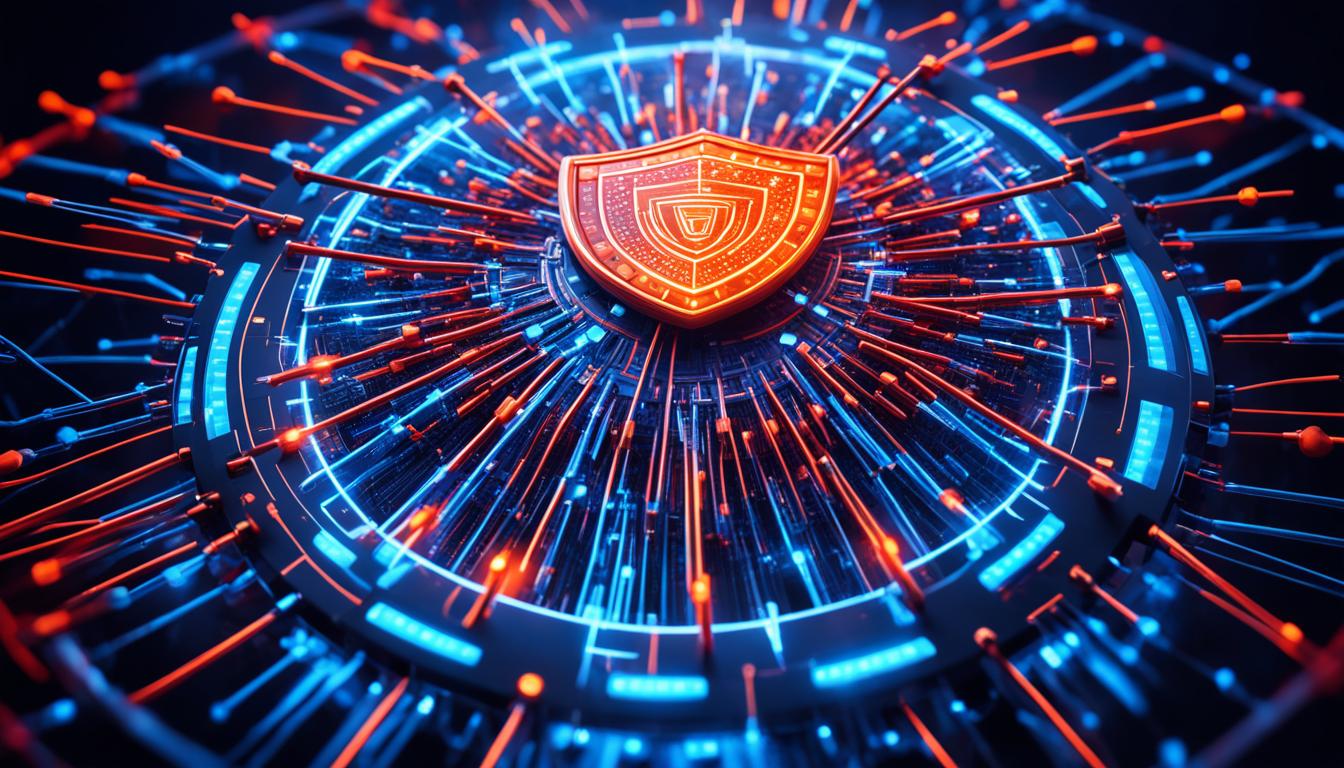Welcome to our in-depth exploration of how Artificial Intelligence (AI) and Machine Learning (ML) are revolutionizing the field of Cybersecurity. In an increasingly digital world, where threats to data security and network integrity are on the rise, organizations and individuals need advanced tools and techniques to combat cyber threats effectively. AI and ML technologies are paving the way for a new era of cyber defense.
As hackers become increasingly sophisticated, traditional methods of threat detection and vulnerability assessment may fall short. That’s where AI and ML come in. By leveraging the power of AI algorithms and machine learning models, organizations can enhance their capabilities in detecting, preventing, and responding to cyber threats.
With AI and ML, cybersecurity professionals can analyze vast amounts of data in real-time, identify patterns and anomalies, and predict potential threats before they wreak havoc. These technologies enable proactive measures and empower organizations to bridge the gap between the ever-evolving threat landscape and traditional security measures.
Throughout this article, we will delve into the different ways AI and ML are transforming cybersecurity. We will explore their applications in threat detection, vulnerability assessment, data protection, network security, and more. Additionally, we will discuss the ethical considerations of using AI in cybersecurity and how organizations can navigate the complex landscape of AI security automation.
Key Takeaways:
- AI and ML technologies are revolutionizing cybersecurity by enhancing threat detection, vulnerability assessment, and data protection.
- AI-powered cybersecurity solutions empower organizations to address the evolving cyber threat landscape effectively.
- Machine learning algorithms enable proactive measures and real-time analysis of vast amounts of data for improved security.
- Ethical considerations, such as bias in AI algorithms and privacy concerns, must be addressed when implementing AI in cybersecurity.
- AI can alleviate the cybersecurity skills shortage by automating security systems and enhancing workforce efficiency.
Understanding the AI and Cybersecurity Intersection
In today’s rapidly evolving digital landscape, the role of artificial intelligence (AI) in strengthening cybersecurity defenses has become increasingly significant. AI technologies, powered by machine learning algorithms, offer innovative solutions for threat detection, vulnerability assessment, and network security. By leveraging the power of AI, organizations can effectively combat cyber threats and protect against evolving risks.
The Basics of AI in Cybersecurity
AI, in the context of cybersecurity, refers to the use of intelligent algorithms and models to automate processes, analyze vast amounts of data, and identify potential threats. AI brings automation, speed, and accuracy to cybersecurity, enabling organizations to enhance their defense capabilities. It enables security teams to detect and respond to threats more efficiently, freeing up valuable time and resources.
How Artificial Intelligence Strengthens Cyber Defenses
Artificial intelligence strengthens cyber defenses by providing advanced capabilities in threat detection and response. AI technologies can analyze massive volumes of data in real-time, identifying patterns and anomalies that may indicate a potential cyber attack. By leveraging AI-powered solutions, organizations can proactively detect and mitigate threats, reducing response times and minimizing the impact of attacks.
Key AI Technologies Driving Cybersecurity Today
Several key AI technologies are driving advancements in cybersecurity:
- Machine Learning: Machine learning algorithms enable systems to learn from data, detect patterns, and make predictions. These algorithms power AI-driven threat detection systems and enhance vulnerability assessment processes.
- Deep Learning: Deep learning algorithms, a subset of machine learning, excel at analyzing complex, unstructured data, such as images and texts. Deep learning enables advanced threat detection and real-time data protection.
- Natural Language Processing (NLP): NLP algorithms process and understand human language, enabling the analysis of text-based data, such as emails or social media posts. NLP enhances phishing detection and helps identify malicious activities.
- Computer Vision: Computer vision algorithms enable systems to interpret and understand visual data, such as images and videos. Computer vision enhances surveillance and helps detect suspicious activities or objects.
- Behavioral Analytics: Behavioral analytics algorithms analyze user behavior and identify anomalies or deviations from normal patterns. These algorithms are particularly effective in detecting insider threats and identifying compromised accounts.
By harnessing these AI technologies, organizations can build robust cybersecurity systems that can adapt, learn, and evolve to combat emerging threats.
| AI Technologies | Cybersecurity Applications |
|---|---|
| Machine Learning | Threat Detection, Vulnerability Assessment, Anomaly Detection |
| Deep Learning | Real-Time Data Protection, Image Analysis, Fraud Detection |
| Natural Language Processing | Phishing Detection, Malicious Activity Analysis |
| Computer Vision | Video Surveillance, Object Detection, Threat Identification |
| Behavioral Analytics | User Behavior Analysis, Insider Threat Detection |
The integration of AI technologies in cybersecurity holds immense potential in ensuring robust defense against cyber threats. By understanding the intersection of AI and cybersecurity, organizations can leverage these technologies to safeguard their systems, networks, and sensitive data.
Revolutionizing Threat Detection with AI
In today’s rapidly evolving digital landscape, organizations face an ever-increasing number of sophisticated cyber threats. Traditional methods of threat detection and mitigation are no longer sufficient to protect against these advanced threats. That is why the integration of AI-driven systems and machine learning technologies has become crucial in the field of cybersecurity.
AI-Driven Threat Detection Systems
AI-driven threat detection systems leverage the power of machine learning algorithms to identify and mitigate cyber threats in real-time. These systems continuously analyze vast amounts of data, including network traffic patterns, user behavior, and system logs, to detect anomalies and potential security breaches.
With AI-driven threat detection systems, organizations can proactively monitor their networks and quickly respond to emerging threats. They can pinpoint and neutralize potential vulnerabilities, thereby strengthening their cybersecurity defenses and preventing significant cyber incidents.
Machine Learning for Anomaly Detection
Machine learning plays a crucial role in detecting anomalies, which are often indicators of potential cyber threats. By training machine learning models on large datasets of normal behavior, these models can accurately identify deviations from the norm that may signify malicious activities.
Using anomaly detection powered by machine learning, organizations can detect and respond to emerging cyber threats promptly. The ability to identify and address anomalous behavior in real-time significantly reduces the time to detect and mitigate potential risks, minimizing the potential impact on the organization’s operations and data security.
Predictive Analytics in Identifying Cyber Threats
Predictive analytics, another application of AI in cybersecurity, involves using historical data and machine learning algorithms to forecast potential cyber threats and their characteristics. By analyzing patterns and trends in previous cyber attacks, predictive analytics can effectively identify emerging threats and provide organizations with valuable insights to fortify their defenses.
With predictive analytics, security teams can stay one step ahead of cybercriminals by anticipating their tactics and implementing proactive measures to mitigate risks. This predictive approach allows organizations to adopt a pre-emptive rather than a reactive strategy in dealing with cyber threats.
By harnessing the power of AI-driven systems, machine learning, anomaly detection, and predictive analytics, organizations can revolutionize their threat detection capabilities and enhance their cybersecurity posture. These advanced technologies enable proactive identification and mitigation of cyber threats, improving overall resilience against evolving security challenges.

Machine Learning for Proactive Vulnerability Assessment
In today’s rapidly evolving cyber threat landscape, organizations must adopt proactive approaches to vulnerability assessment to ensure robust cybersecurity. Machine learning offers advanced capabilities that can automate vulnerability scanning, prioritize risks, and enable effective patch management.
Machine learning algorithms leverage data analysis and pattern recognition to identify potential vulnerabilities and assess their severity. By analyzing historical data and security patterns, these algorithms can predict and prioritize risks, allowing organizations to allocate appropriate resources for mitigation.
One of the key benefits of machine learning in vulnerability assessment is its ability to automate the scanning process. Traditionally, manual vulnerability scanning can be time-consuming and resource-intensive. Machine learning algorithms automate this process by continuously monitoring systems and applications, enabling organizations to identify vulnerabilities in real-time.
Furthermore, machine learning aids in risk prioritization, allowing organizations to focus on addressing vulnerabilities with the highest potential impact. By considering factors such as the criticality of assets, potential exploitation risks, and the likelihood of an attack, machine learning algorithms help prioritize vulnerabilities that require immediate attention.
Additionally, machine learning facilitates effective patch management by recommending appropriate patches or remediation measures for identified vulnerabilities. These recommendations are based on historical data, industry best practices, and the analysis of potential impact. This enables organizations to address vulnerabilities efficiently, reducing the window of opportunity for potential attackers.
By incorporating machine learning into vulnerability assessment processes, organizations can enhance their cybersecurity vulnerability management capabilities. With the automation of vulnerability scanning, risk prioritization, and patch management, machine learning empowers organizations to stay ahead of emerging threats and strengthen their overall cybersecurity posture.
AI Machine Learning Cybersecurity Tools and Techniques
In this section, we will explore the various AI machine learning cybersecurity tools and techniques. By harnessing the power of AI and machine learning, organizations can enhance their cybersecurity measures and effectively combat cyber threats.
AI-powered security solutions utilize machine learning algorithms to improve several critical areas of cybersecurity:
- Threat Hunting: AI analyzes vast amounts of data to identify hidden threats and potential vulnerabilities, enabling proactive threat detection and prevention.
- Incident Response: AI automates incident response processes, enabling rapid detection, analysis, and containment of security breaches.
- Fraud Detection: Machine learning algorithms can identify patterns and anomalies in user behavior to detect and prevent fraudulent activities in real-time.
- Malware Analysis: AI-powered systems can analyze and classify malware, enhancing the detection and mitigation of sophisticated cyber attacks.
These AI machine learning cybersecurity tools and techniques empower organizations to safeguard their networks and data effectively. By leveraging AI-powered solutions, businesses can stay one step ahead of cybercriminals and minimize the impact of potential security incidents.

| Tool/Technique | Description |
|---|---|
| Threat Hunting | AI analyzes large datasets to proactively identify and detect potential cyber threats before they can cause harm. |
| Incident Response | AI automates incident response processes, enabling swift detection, analysis, and containment of security breaches. |
| Fraud Detection | Machine learning algorithms identify patterns and anomalies in user behavior to detect and prevent fraudulent activities in real-time. |
| Malware Analysis | AI-powered systems can analyze and classify malware, enhancing the detection and mitigation of sophisticated cyber attacks. |
The Role of AI in Ensuring Network Security
In this section, we will explore the role of AI in ensuring network security. With the increasing sophistication of cyber threats, organizations need robust measures to protect their network infrastructure. AI-powered solutions have emerged as crucial tools in safeguarding networks from intrusions and securing the network perimeter.
Securing the Network Perimeter with Advanced AI
The network perimeter is the first line of defense against unauthorized access and cyber attacks. AI technologies, such as machine learning algorithms, enable organizations to strengthen their perimeter security by detecting and preventing unauthorized activities. By analyzing network traffic in real-time, AI systems can identify anomalies and flag suspicious behavior, allowing organizations to take proactive measures to mitigate potential threats.
AI Solutions for Intrusion Detection and Prevention
AI-based intrusion detection systems (IDS) play a crucial role in identifying and responding to potential security breaches. These systems use sophisticated algorithms to analyze network data and identify patterns indicative of an intrusion. By continuously monitoring network activities, AI-powered IDS can provide real-time alerts and help administrators take immediate action to prevent further damage.
Machine Learning Algorithms in Traffic Analysis
Traffic analysis is essential for understanding network behavior and identifying potential security risks. Machine learning algorithms can analyze vast amounts of network traffic data, identify patterns, and detect abnormalities or signs of malicious activity. By leveraging machine learning, organizations can gain valuable insights into network traffic, improve threat detection capabilities, and enhance overall network security.

Network Security Solutions
| Network Security Challenge | AI Solution |
|---|---|
| Intrusion Detection | AI-powered intrusion detection systems (IDS) continuously monitor network traffic, analyze patterns, and alert administrators of potential threats. |
| Intrusion Prevention | AI systems can proactively identify and block potential intrusions by analyzing network traffic, behavior, and known threat indicators. |
| Traffic Analysis | Using machine learning algorithms, organizations can analyze network traffic for anomalies, detect malicious activity, and enhance network security. |
The integration of AI in network security solutions empowers organizations to stay one step ahead of cyber threats. By leveraging advanced AI technologies, organizations can protect their network infrastructure, detect and prevent intrusions, and analyze network traffic with greater efficiency and accuracy.
Enhancing Data Protection Through Machine Learning
In today’s rapidly evolving digital landscape, data protection is of paramount importance. With the increasing volume of sensitive information being stored and transmitted across various platforms, organizations need robust mechanisms to safeguard their data from unauthorized access and breaches. Machine learning has emerged as a powerful tool in enhancing data protection, offering innovative solutions for ensuring data privacy, encryption, and real-time security.
Data Encryption and AI: The Future of Data Privacy
Data encryption plays a crucial role in safeguarding sensitive information from potential threats. By leveraging the capabilities of artificial intelligence, organizations can enhance data privacy through advanced encryption techniques. AI-driven encryption algorithms ensure that data is protected both at rest and in transit, making it extremely difficult for unauthorized individuals to decipher or access the information.

AI-powered data encryption enables organizations to keep their confidential data secure, even in the event of a breach. By automating encryption processes, organizations can consistently apply encryption across their entire data ecosystem, ensuring comprehensive data protection.
Behavioral Analytics and AI for Sensitive Data Security
Behavioral analytics, combined with AI, empowers organizations to detect anomalous user behavior and potential threats more effectively. By leveraging machine learning algorithms that analyze user patterns and behaviors, organizations can identify suspicious activities and take proactive measures to mitigate risks.
AI-based behavioral analytics monitor user interactions with data, applications, and systems, detecting deviations from established patterns. This allows organizations to identify potential insider threats, unauthorized access attempts, or abnormal data usage, enhancing sensitive data security.
“The integration of behavioral analytics and AI offers organizations a data-centric approach to security. By understanding user behavior and leveraging AI algorithms, organizations can identify anomalies and potential breaches in real-time.”
– John Green, Chief Security Officer at SecureTech
Deep Learning for Real-Time Data Protection
Deep learning, a subset of machine learning, excels in analyzing complex patterns and detecting advanced threats. Organizations can leverage deep learning algorithms to monitor network traffic, identify malicious activities, and protect sensitive data in real-time.
Start earning effortlessly! Claim your $3 bonus and monetize your unused data with Honeygain. It’s simple, secure, and smart.
Claim Nowand watch your balance grow! 🍯💸
By training deep learning models with large datasets, organizations can establish robust defense mechanisms against evolving cyber threats. These models can accurately detect malware, phishing attempts, and other malicious activities, enabling organizations to take immediate action to mitigate risks.
Ensuring Comprehensive Data Protection
| Data Protection Measures | Machine Learning Techniques |
|---|---|
| Data Encryption | AI-powered encryption algorithms for secure data storage and transmission |
| Behavioral Analytics | AI-driven analysis of user patterns and behaviors to detect anomalies |
| Real-Time Protection | Deep learning models for real-time detection and mitigation of threats |
By combining data encryption, behavioral analytics, and deep learning, organizations can ensure comprehensive data protection. Machine learning techniques enable organizations to stay one step ahead of cyber threats and provide effective safeguards for sensitive data.
The transformative power of machine learning in enhancing data protection cannot be overstated. As organizations continue to face increasingly sophisticated cyber threats, leveraging AI-driven technologies is crucial to maintaining data privacy and security. By implementing robust data protection measures that incorporate machine learning, organizations can mitigate risks, build customer trust, and safeguard their most valuable asset – data.
Strategies for AI-Enhanced Cybersecurity Measures
In this section, we will discuss strategies for implementing AI-enhanced cybersecurity measures. By integrating AI into your cybersecurity strategies, you can improve your threat intelligence, enhance security automation, and optimize your incident response planning. These strategies will help you leverage AI to enhance your cybersecurity defenses effectively.

Enhancing Threat Intelligence
AI integration allows you to gather and analyze vast amounts of data, enabling you to identify and respond to emerging threats in real-time. By harnessing the power of AI, you can augment your threat intelligence capabilities and stay one step ahead of cybercriminals.
Automating Security Procedures
With AI-driven automation, you can streamline security processes and reduce the burden on your cybersecurity team. By automating routine tasks such as patch management and vulnerability scanning, you can free up your resources to focus on more critical aspects of cybersecurity.
Optimizing Incident Response Planning
AI integration enables you to improve your incident response planning by leveraging machine learning algorithms to detect and respond to threats swiftly. By automating incident response procedures, you can minimize the impact of cyberattacks and reduce downtime.
Implementing AI-enhanced cybersecurity measures empowers you to proactively defend against evolving threats and safeguard your organization’s sensitive data. By leveraging AI’s capabilities in threat intelligence, security automation, and incident response planning, you can strengthen your cybersecurity defenses and stay ahead of cybercriminals.
Navigating the Complex Landscape of AI Security Automation
In this section, we will navigate the complex landscape of AI security automation. We will discuss automated incident response with AI and machine learning, the transformation of digital forensics with AI, and the role of AI in security operations for next-level efficiency. AI security automation streamlines cybersecurity processes and enables organizations to detect and respond to threats more effectively.
Automated Incident Response with AI and Machine Learning
Automated incident response is a critical component of AI security automation. By harnessing the power of AI and machine learning, organizations can rapidly detect and respond to cyber threats in real-time. AI algorithms analyze vast amounts of data, enabling automated incident response systems to identify patterns, detect anomalies, and autonomously take action to mitigate threats.
AI-driven incident response systems, powered by machine learning, provide organizations with a proactive approach to cybersecurity. These systems can continually learn and evolve, adapting to emerging threats and improving their response capabilities over time. By automating incident response, organizations can reduce response time, minimize manual errors, and enhance their ability to neutralize threats before they cause significant damage.
The Transformation of Digital Forensics with AI
AI has revolutionized digital forensics, enabling investigators to analyze massive volumes of data more efficiently and accurately. Machine learning algorithms can sift through vast amounts of digital evidence, detect patterns, and uncover hidden connections that would be nearly impossible for humans to identify manually.
With AI in digital forensics, investigators can quickly identify relevant artifacts, piece together timelines, and reconstruct digital events, empowering them to uncover the full scope of cybercrimes. AI-powered tools can also automate the extraction of actionable intelligence from digital evidence, accelerating the investigation process and enabling timely responses to cyber threats.
AI in Security Operations: Next-Level Efficiency
AI plays a pivotal role in enhancing the efficiency of security operations. By automating repetitive and time-consuming tasks, AI-powered systems free up security professionals to focus on more complex and strategic activities.
Machine learning algorithms can analyze vast amounts of security data, flagging potential threats, and providing actionable insights to security teams. AI-powered security operations centers (SOCs) can conduct real-time monitoring, threat hunting, and incident response, streamlining the overall cybersecurity workflow.
Furthermore, AI automates the process of threat investigation and remediation by recommending and implementing appropriate security measures. This automation not only enhances efficiency but also improves the accuracy and consistency of security operations, ensuring organizations can effectively detect, prevent, and respond to threats.
| Benefits of AI Security Automation | Challenges of AI Security Automation |
|---|---|
|
|
Tackling the Ethical Implications of AI in Cybersecurity
In this section, we will delve into the ethical implications of AI in cybersecurity and explore the duality of AI’s role in ensuring ethical use in the field. Additionally, we will address the issue of bias in AI cybersecurity solutions and the privacy concerns associated with AI-powered surveillance.
The Duality of AI: Ensuring Ethical Use in Cybersecurity
As AI continues to advance in the cybersecurity landscape, it is essential to understand its duality. While AI offers tremendous opportunities for improving security measures, its deployment must be guided by ethical principles to mitigate potential risks. Organizations must ensure that AI technologies are utilized responsibly, taking into account factors such as data privacy, informed consent, and transparency in decision-making processes. By prioritizing ethical considerations, we can harness the full potential of AI without compromising trust and integrity in cybersecurity practices.
Addressing Bias in AI Cybersecurity Solutions
Bias in AI is a significant concern in cybersecurity. AI algorithms learn from historical data, and if that data contains biases, it can perpetuate them in decision-making processes. This bias can result in discriminatory outcomes and contribute to unfair practices in cybersecurity. It is crucial to address and mitigate bias by continuously monitoring and reassessing AI models, ensuring diverse and representative training datasets, and implementing rigorous testing protocols. By addressing bias, we can build AI cybersecurity solutions that are fair, unbiased, and equitable.
Privacy Concerns With AI-Powered Surveillance
The integration of AI in surveillance systems raises legitimate privacy concerns. AI-powered surveillance technologies, such as facial recognition and behavioral monitoring, have the potential to collect vast amounts of personal data and invade privacy rights. Striking the right balance between security and privacy is essential. Organizations must implement robust privacy frameworks, including clear policies, data protection mechanisms, and uses of AI surveillance that align with legal and ethical standards. Ensuring privacy safeguards will help build public trust and mitigate the potential for misuse of AI-powered surveillance systems.
Alleviating Cybersecurity Skills Shortage with AI
In the rapidly evolving landscape of cybersecurity, the demand for skilled professionals continues to outpace the available talent. This cybersecurity skills shortage has become a significant challenge for organizations looking to protect their networks and data from cyber threats. However, the integration of artificial intelligence (AI) in the cybersecurity workforce offers promising solutions.
AI-powered cybersecurity tools and automated security systems are revolutionizing the field, bridging the skill gap and enhancing workforce efficiency. By leveraging AI in the cybersecurity workforce, organizations can effectively address the shortage of skilled professionals and better protect their digital assets.
The use of automated security systems powered by AI allows organizations to detect, analyze, and respond to threats in real-time. These systems employ advanced algorithms to identify patterns and anomalies that could indicate potential cyber attacks, reducing the reliance on manual processes and human error. With AI-powered cybersecurity tools, organizations can automate routine tasks, freeing up skilled professionals to focus on more complex issues and strategic initiatives.
AI not only enhances the efficiency of the cybersecurity workforce but also enables organizations to respond more effectively to emerging threats. By analyzing vast amounts of data and applying machine learning algorithms, AI-powered tools can uncover hidden patterns and trends, identify potential vulnerabilities, and proactively mitigate cyber risks.
“The integration of AI in the cybersecurity workforce enhances the capabilities of security professionals. With AI-powered tools and automated systems, organizations can more efficiently detect and respond to cyber threats, helping to bridge the skill gap,” says cybersecurity expert Sarah Thompson.
The implementation of AI in the cybersecurity workforce is an essential step in addressing the skills shortage and ensuring the protection of critical information. By harnessing the power of AI-powered cybersecurity tools and automated security systems, organizations can enhance their cybersecurity measures and stay ahead of evolving cyber threats.
Benefits of AI in the Cybersecurity Workforce
| Benefits | Description |
|---|---|
| Bridge the skills gap | AI-powered cybersecurity tools enable organizations to address the shortage of skilled cybersecurity professionals. |
| Enhance workforce efficiency | Automated security systems free up skilled professionals to focus on strategic initiatives and more complex security issues. |
| Effective threat detection | AI algorithms can analyze vast amounts of data to identify patterns and anomalies, helping to detect and respond to threats in real-time. |
| Proactive risk mitigation | By leveraging machine learning algorithms, AI-powered tools can proactively identify vulnerabilities and mitigate cyber risks. |
As the cybersecurity landscape continues to evolve, the integration of AI in the workforce will be crucial in addressing the skills shortage and bolstering the efficiency of cybersecurity measures. By leveraging AI-powered cybersecurity tools and automated security systems, organizations can enhance their capabilities, bridge the skill gap, and protect against emerging cyber threats.
Conclusion
In conclusion, the impact of AI and machine learning technologies on cybersecurity is undeniable. These advancements have revolutionized threat detection, vulnerability assessment, and data protection, providing organizations with powerful tools to combat evolving cyber threats. AI-driven cyber defense has become a crucial aspect of cybersecurity strategies, enhancing network security, incident response, and data privacy.
The future of cybersecurity lies in the continued integration of AI, as it enables organizations to stay one step ahead of cybercriminals. AI-powered threat detection systems, proactive vulnerability assessment, and machine learning cybersecurity tools and techniques have proven to be highly effective in mitigating risks. By leveraging AI, organizations can achieve a stronger cybersecurity posture and protect their critical assets.
However, as AI becomes increasingly prevalent in cybersecurity, it is essential to address the ethical implications associated with its use. Ensuring the ethical use of AI, addressing bias in AI cybersecurity solutions, and balancing privacy concerns are vital considerations. As the cybersecurity landscape continues to evolve, it is crucial to prioritize cybersecurity innovation to keep pace with emerging threats.
In conclusion, AI and machine learning technologies have transformed the field of cybersecurity, ushering in a new era of AI-driven cyber defense. The future of cybersecurity relies on harnessing the power of AI to detect, prevent, and respond to cyber threats. By embracing these technologies responsibly and promoting continued innovation, organizations can fortify their defense against the ever-evolving cybersecurity landscape.

